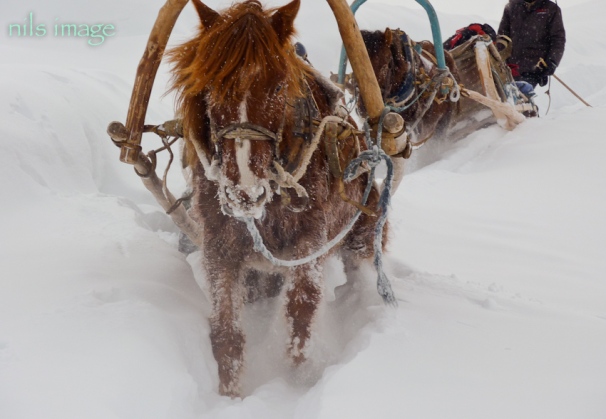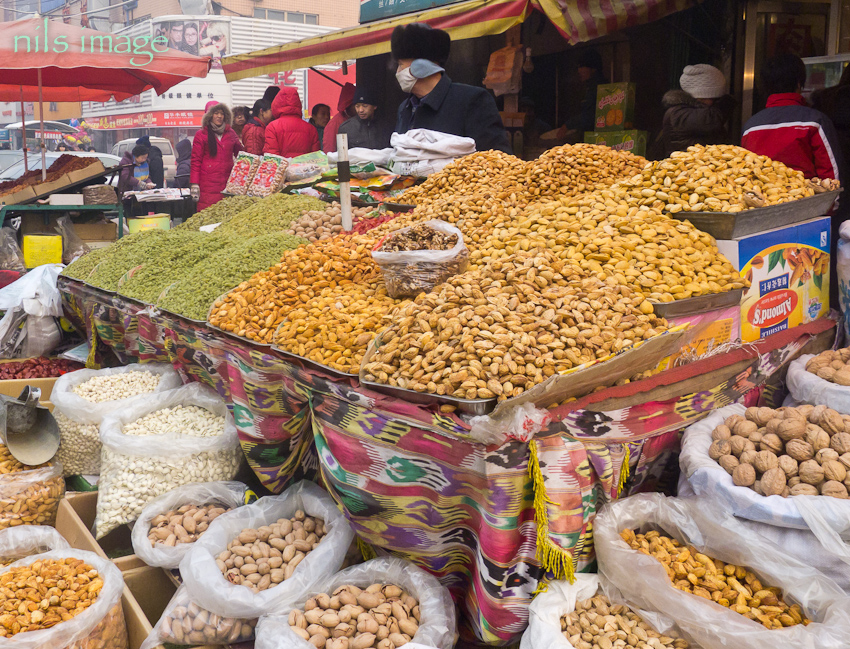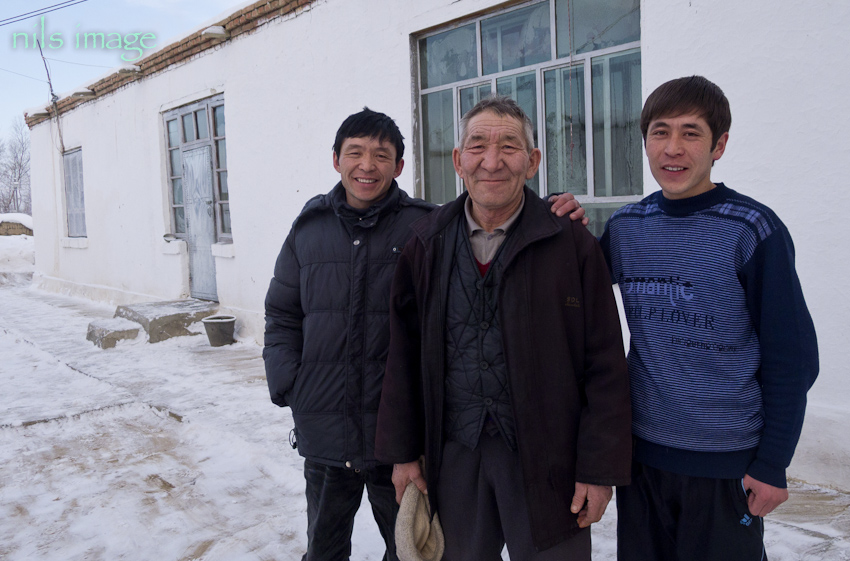January 22nd, 2010
After five days in Altay City I was ready to get out of Dodge and into the mountains. In Burqin we had to do some fast talking (that would be the master of fast talking – Ayken) with the military in charge of border areas just to get the permit to head back to my normal haunts. The big snows, closed roads, and general concern with the ethnic unrest (completely absent from the mountain areas) had the officials being very cautious. On my suggestion we finally signed our lives away with releases – perhaps a first in this region – and took a bus to Chunkor and our waiting friends. A huge relief as it seemed likely that we would not be allowed into the mountains at all. More snow fell as we arrived and we found the road to be completely closed, no horses or sleds had even made it through. In fact, on the steep switchbacks out of the valley a horse and chana had been caught in an avalanche a few days prior to our arrival and the horse was killed.
We drove up the road on our 2nd day in Chunkor to check on the plowing progress. Progress was glacial slow and the snow was piled high, in places way over our heads. They had one large front end loader doing the work and it seemed woefully inadequate to the task at hand.
Ayken and I had lined up Norbek to be our horseman and we had 2 sleds, one belonging to Norbek and one from Done’s family where I was staying. On day three we set out, quickly overtaking the front end loader clearing the road and heading up a steep ramp of snow into the unplowed beyond. We passed a few chanas coming down which made our climb easier and gave us a bit of hope. As we reached the top of the main climb out of the valley the weather deteriorated and the snow started in again in ernest……
An auspicious sign – ski tracks in the valley just out of Chunkor.
Leaving Done’s early on the 25th of January.
The chana ride through various settlements in the Chunkor valley.
On the plowed section of the road.
This is the end of the plowed road, and the start of more snow.
We came across a few chanas and some Kazakhs taking a string of horses up to their village. The horses and the drivers were a stoic lot, heads down and no chitchat. Steely eyes that would make Clint Eastwood look positively moony eyed.
We moved at the same pace as the horses and drivers for a few hours, with the weather deteriorating as we continued up the trail.
This is actually 1/2 of a two picture panorama. The wind had reduced visibility and the horses and their minders had reached the spot to turn off the road and follow the trail to their settlement, still miles away. They were just trying to keep there horses together enough to not loose track of them in the snow. We wished them luck – auk jol bolson – literally, a good white road, white being the color of good things and good luck.
A short stop and Ayken produced a small flask of what we had coined on the first trip “Dirty Sneaker Juice”. Not recommended.
Chunkor to Tas Wue (stone house), about 48kms, is mostly uphill but we can cover the distance in a long day. In these conditions we only made it about 1/2 way before we decided to stop. The horses were tired and so were we. In fading light we pulled off at a flat roofed log house with large barking dogs, something Ayken and Norbek are very uncomfortable with. I pointed out that though they were barking fiercely, their tales were doing an occasional wag. They both considered this irrelevant to the issue, but I felt better.
The family was Kazakh and, as is usually the case, things were a bit tense to start with. As soon as mutual connections, friends, and families were established all was well. We had a big dinner of Longman (homemade noodles and meat) and slept well.
We were up early. After numerous cups of milk tea enriched with floating dollops of sour butter and chunks of bread , we were on our way again.
From our stay here we found little in the way of recent tracks. The snow had stopped but the road and over laid horse trail was increasingly filled in. The horses proved themselves once again, pulling the loaded chanas through deeper and deeper snow and drifts. After hours of this I could tell Norbek was getting concerned. The day was passing and our progress was slowing. We decided to ski in front and break at least a bit of a trail for the horses and chanas. I had my pair of western skis and we had a pair of Altai skis that Norbek had brought along. Ayken took these after some grumbling and soon found they were easier then walking through the deep snow with his (admittedly) short legs. It was at this point that Ayken finally got why skis were so essential in the winter. An abstraction became a reality.
The horses doing their valiant best.
Ayken the skier, helping to break trail for horses.

Nearing the top of the pass and Tas Wue.
We had been told that the front end loader stationed near Tas Wue was out of fuel so was basically a dead machine. As rumor/news often does, this turned out to be false and as we neared Tas Wue we heard the sound of a front end loader clearing the road toward us. The 2 Chinese running the machine were a bit shocked to see us. They pulled off and we exited the unplowed road down onto the plowed and quickly make our way to Tas Wue and the widow’s gust house, one we have used as a way station over the years.
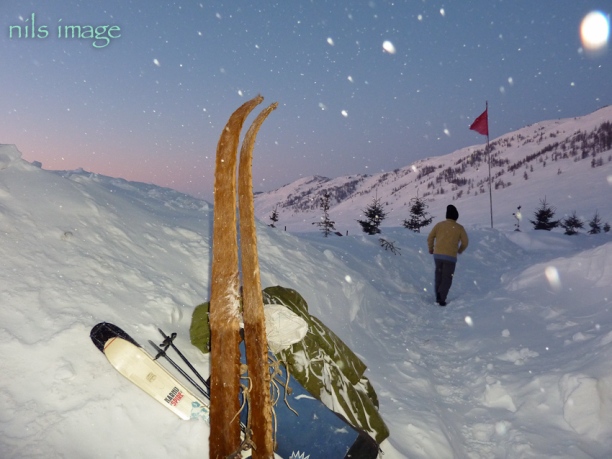 Evening and our arrival at Tas Wue.
Evening and our arrival at Tas Wue.
Our start to Kanas , rabbit (Quoeyan)tracks in the foreground.

The junction-and the halfway point. To the right is the road to Hkom and straight ahead is Kanas. We choose to go to Kanas.
Jaldung Wue (house of Jal), the summer resort for Kanas. Started in 2003-4, it is now quite large and grows every year. Buildings look to me to be some kind of weird euro disney theme and don’t have a context to either the culture(s) or landscape. Clearly my taste run different then the Chinese developers of this rather well appointed resort. The place is entirely shut down in the winter. Amidst these modern digs there is one set of old log houses, perhaps the original House of Jal……
The Buildings are laid out in fleets across the valley, each with its own town center tower.
Ski tracks on the way to Kanas. On the left is a up track, notice the pole marks on the left. Behind Ayken is a downtrack to the road. The big snows of 2010 had definitely increased ski usage. I saw more tracks in a few days then I had seen in an entire trip on previous years.
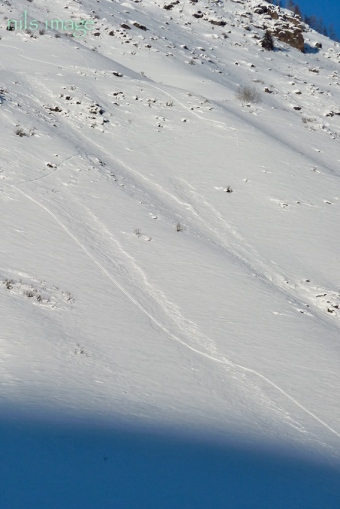
A steep and long downhill track. The local skis have permanent skins on the bottom so their skis are a bit slower then our modern skis, but the skier who made this track was definitely moving at a good clip on this run.
Another impressive downhill run.
The Kanas River about 15km shy of Kanas Lake.











